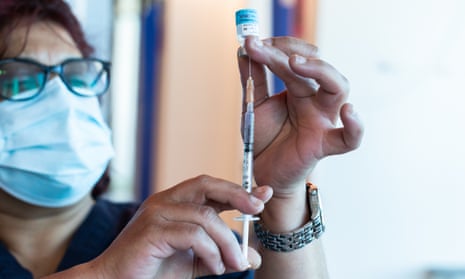The commonwealth health department has vaccinated only half of Australia’s aged and disability care residents despite initially saying they would be given their shots within six weeks.
The federal government has also been accused of lacking a clear plan for vaccinating aged care staff despite being five weeks into the program’s rollout.
Government minister David Littleproud on Wednesday sought to blame the states for doing “bugger all” on the vaccine rollout, prompting a furious reaction from ministers in New South Wales, Queensland and the Australian Capital Territory, and calls from the Greens for an inquiry into the commonwealth’s failings.
A key area of responsibility for the federal government is vaccinating aged care staff and residents who are both in the highest priority group for vaccinations – phase 1a. Initially, the government said it had planned to complete phase 1a within roughly six weeks of the program’s commencement on 22 February.
That included vaccinating 190,000 aged and disability care residents and 318,000 aged care and disability staff.
With less than a week left until it hits the six-week target, the government has vaccinated roughly 99,000 aged and disability care residents. It has not said how many aged care staff have been vaccinated.
The Council on the Ageing chief executive, Ian Yates, said the targets were always “somewhat ambitious” and believes the government overpromised.
But Yates said he is most worried about the absence of a clear plan for the vaccination of aged care workers, five weeks into the rollout.
“My sense is that, by and large, although there are patches, the vaccination of residents is now proceeding,” Yates said.
“But there’s no clarity around the timetable and process for the vaccination of aged care workers, and that is of concern.”
He said staff were far more likely to be carriers of the virus, making their vaccination critical.
“Vaccination of the staff is really important to the Covid security of residents, and we are concerned that the vaccination of staff doesn’t seem to have a clear strategy at this point,” Yates said.
Staff are being vaccinated separately from aged care residents.
Aged and Disability Advocacy Australia’s chief executive Geoff Rowe said the aged care rollout continued to experience “logistical challenges” and, in particular, communication problems between facilities, residents and the government’s contracted vaccine providers about when deliveries were coming.
Rowe said the outbreaks in Brisbane and Byron Bay reinforced the need for urgency in aged care.
“The residential aged care vaccination has been particularly challenging. It’s been a logistical challenge to get the vaccine to where it needs to be at the right time, at the right place, with the right amount of notice to the residential aged care facility and the residents and families,” he said. “It’s starting to get into a rhythm now where it’s getting out and to a point where we know that there is national coverage, but we’ve got to keep the accelerator on.”
“We see situations like as has occurred with Byron and with Brisbane, and we just can’t get complacent.”
He said the vaccination of residents was the highest priority, but echoed the need for proper planning around the vaccination of aged care workers.
“It’s time now that we have the plans in place for the workforce and for those coming into aged care facilities, such as our aged care advocates,” he said.
The lack of vaccine rollout in aged care has also worried families of residents.
One South Australian man, who asked for anonymity, says his father, aged in his 90s, and other residents at his aged care facility were yet to be vaccinated.
The staff, residents and their families had been given no clue as to when the vaccination might take place. The earliest it could occur is in mid-to-late April, he said.
“It seems to me that this is a potential disaster waiting to happen,” he told the Guardian. “All it needs is for a staff member or visitor with the UK variant to enter a home which has not been vaccinated, and we are immediately back where Vic was last year with aged care.”
Health minister Greg Hunt said on Wednesday that the national vaccination program was now “accelerating as intended0”.
The government has already missed its initial target of 4m vaccinations by the end of March, though that target was revised due to problems with international supply. The government now hopes to have all first doses administered by October. The government hit a record high number of vaccinations with 72,000 on Wednesday.
“We were conservative in our estimates,” Hunt said. “The best advice that we have, as Prof Murphy reaffirmed when he stood up with the prime minister recently, is that we remain on track to complete first doses for all Australians who seek it by the end of October.”
General practitioners, who are responsible for the bulk of phase 1b vaccinations, continue to report problems with vaccine supply and delivery. Shipments are, in some cases, turning up days late, forcing the cancellation of bookings and wasted staff costs.
